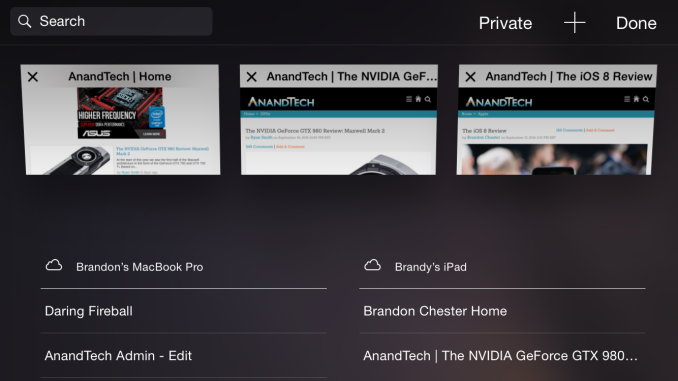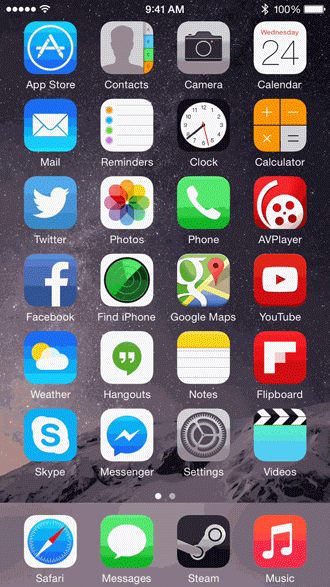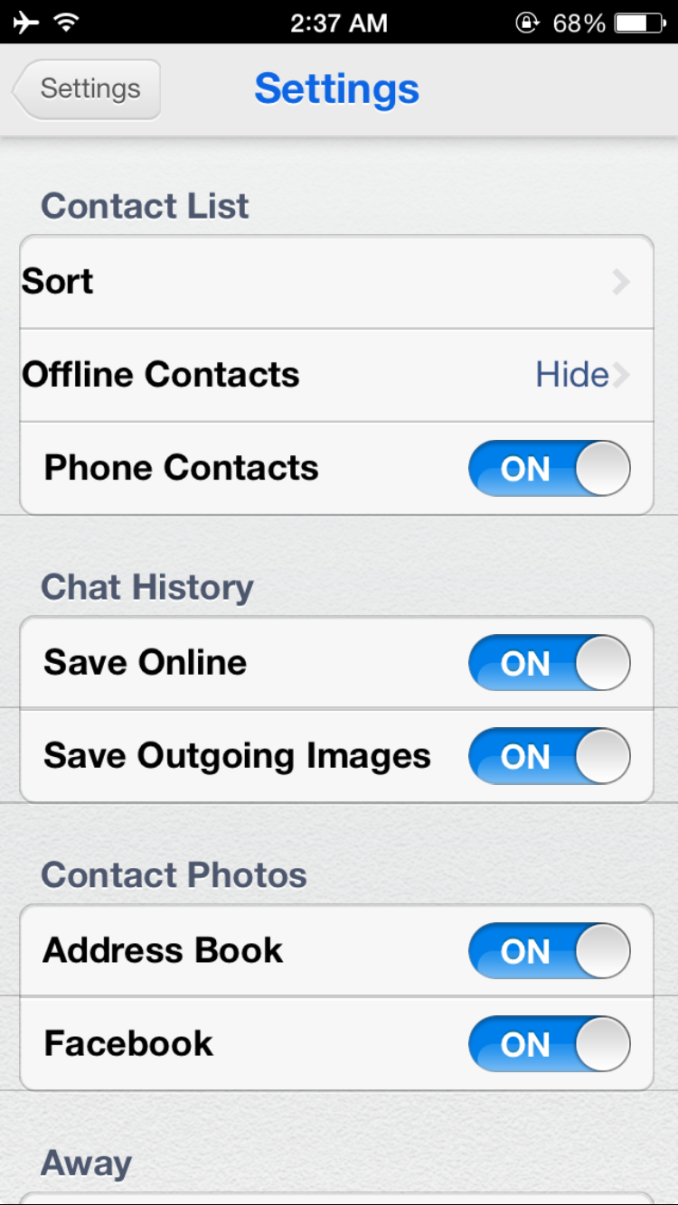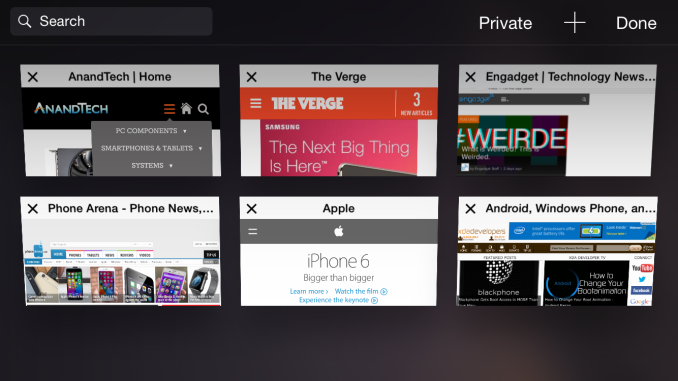The iPhone 6 Review
by Joshua Ho, Brandon Chester, Chris Heinonen & Ryan Smith on September 30, 2014 8:01 AM EST- Posted in
- Smartphones
- Apple
- Mobile
- iPhone 6
Design
The iPhone 6 comes with Apple’s newly released iOS 8. For a full rundown of everything Apple is bringing to the table with iOS 8 you can read our review of the operating system itself. iOS 8 also includes changes that are specific to the iPhones 6 and 6 Plus. Much like when Apple moved from the 3.5” 3:2 display in previous iPhones to the 4” 16:9 display on the iPhone 5, these changes are to add support for the new display on the iPhone 6. The home screen now displays an additional row of icons, meaning that it fits even more than an iPad. In addition, all of Apple’s default applications have been updated to take advantage of the larger, higher resolution screen.
Weather. iPhone 6 on the left, iPhone 5s on the right.
In the case of applications like Calculator, the interface simply has larger assets with the same layout as the 4” iPhones. Other applications like Settings and Notes display the elements of the interface at the same size as previous iPhones which allows more to be fit on the screen. Unlike the iPhone 5 which shared the same width as previous iPhones, the increase in space applies along both display axes on the iPhone 6 Plus. This is well demonstrated by the new Weather application which now fits more of the hourly forecast horizontally and more of the weekly forecast vertically.
The keyboard has also been updated to take advantage of the larger display when in landscape mode. The right side of the keyboard has been given dedicated keys for moving the cursor left and right in a text box, as well as a period button. The left side has an undo key and a comma. When the emoji keyboard is enabled it also receives a dedicated button next to the toggle between letters and numbers/special characters.
Another application with landscape specific improvements is Safari. While the iPhone 6 does not get the new split landscape views in applications that the 6 Plus has, it does get the horizontal tab view in Safari and the sliding bookmark menu on the new tab page. What's interesting is that this Safari interface is nearly identical to that of the iPad version, which is similar to Safari on OS X Yosemite. The one difference is that tabs in the tab view that are from the same website do not stack on top of each other. Apple really seems to want a unified interface and experience for Safari across all of their platforms, and the general design of the interface has translated well to the various different display sizes on iOS and OS X devices.
The iPhone 6 includes a feature called Reachability for users who find the increased display size difficult to use with one hand. Apple is late to the party with their larger displays, and we’ve seen attempts in the past by other manufacturers to make large devices easier to use. Shrinking the interface and displaying it in a bottom corner was a feature Samsung introduced with the Galaxy Note 3. It wasn’t a very elegant solution, but it worked. Apple’s Reachability feature uses a similar idea but implements it in a more elegant fashion. Double-tapping the capacitive ring around the home button shifts the display downward so the top of applications can be easily pressed. Once an action is performed the interface shifts back into position.
The last new feature specific to the new iPhones is Display Zoom. Display Zoom increases the size of what is displayed so that the interface displays the same amount of information that is shown on the iPhone 5, with an internal rendering resolution of 1136x640. This means that all icons, buttons, etc. are displayed in a much larger size than the default view setting. Because everything is being scaled up to the 1334x750 panel, the interface suffers from the slight blurring that you also see in third party apps that have not been updated to support the new iPhones. This feature is likely aimed at users with aging eyes who would like a bigger display to display bigger controls rather than to display more content, and who aren't concerned about having the sharpest text.
A notable feature that is missing is Apple's new Apple Pay service that works with the NFC hardware in the iPhone 6 and 6 Plus. Although Apple Pay is a feature of the new iPhones and of iOS 8, the service will not be rolling out until October. Other iOS 8 features like SMS Relay and iCloud Photo Library were also absent from the initial iOS 8 release and are scheduled to launch in October. It's likely that the fact that the iOS 8 release date is determined by the yearly release of new iPhones forced some features to be pushed back to a later update.
UX
While the design of iOS 8 itself is generally well-implemented, the user experience ends up a bit more mixed, and the result comes from the confluence of hardware and software. In the case of the iPhone 6, these issues effectively boil down to RAM and odd layouts that come from the upscaling needed for the 1334x750 display. In the case of upscaling artifacts, this is a temporary issue at best but it's glaringly obvious when an application is upscaled in certain cases.
For example, Trillian is an IM application that hasn't been updated in over a year. While it was already lacking in functionality with iOS 7 as it lacked support for the background refresh API, on the iPhone 6 in iOS 8 there are significant issues with consistent spacing and there's also no support for third party keyboards. Once again, it's important to understand that this isn't the result of poor work on Apple's part, but it does show the limits of what can be done with the upscaling system and emphasizes the need for developers to keep their applications updated.
The other issue has the potential to be far more serious. While iOS' software architecture is more RAM efficient due to manual garbage collection and the use of precompiled binaries, it's quite easy for me to push the phone past the breaking point in Safari. For example, six tabs of common websites for mobile devices cannot consistently be held in memory. If I continuously go through all six tabs, at least one will need to reload. In my first attempt at running this test, Safari crashed as I tried to go through all tabs constantly to keep them in memory. I didn't notice this behavior in the new Moto X, which can do the same test without issue. Outside of memory intensive use cases though, the iPhone 6 does respectably and I usually don't notice the lack of RAM. I have to emphasize that this should be a generally unlikely problem, and that the same behavior can be replicated on the iPhone 5s given the same workload. If you did not have issues with out of memory crashes before, there won't be any issues now.
Outside of these two flaws, there's really a lot to like. iOS continues to deliver a relatively well-polished experience that few seem to be able to match. Most of my issues from the iPhone 5s experience have been resolved. For example, it's now possible for me to upload photos to Dropbox selectively instead of turning camera upload on and deleting photos that I don't want to upload. The odd segregation of current notifications and missed notifications has been removed. Swiftkey has been added, although it's not quite the same as the Android version due to the different prediction insertion behavior and keyboard layout.
In addition, although it isn't necessarily the result of software, the larger display really helps with improving touch accuracy when compared to the iPhone 5s. While I haven't been able to try out Apple Pay since it will be launching in October, it also seems to be quite intriguing as the NFC solution is quite novel, though I'd like to see further use of NFC outside of payment and similar applications. TouchID continues to be a key differentiator, and the use of TouchID for Apple Pay authentication would definitely show the strength of Apple's hardware and software integration.



















531 Comments
View All Comments
elajt_1 - Friday, October 3, 2014 - link
(@melgross) And to call you one would be an insult to an idiot.Apart from the rage, I think it was he made some valid points.
Jimrod - Tuesday, September 30, 2014 - link
You mad bro?rational_wannabe - Tuesday, September 30, 2014 - link
You have serious issues. So it's OK for Samsung to sell their plastic crap for the same amount of money? Nice way of rationalizing things...danbob999 - Tuesday, September 30, 2014 - link
Yeah it's OK since there is nothing wrong with plastic. It absorbs shock, is light and do not block wireless signal. Perfect material for a phone. It is also durable enough. How many people replace their phone because the plastic is cracked? Not much. People replace their phone either because the screen is broken, it was damaged by liquid or simply because it is too slow/old.Apple has been selling phones which are cheaper to produce for years at the same price (or higher) than the competition. Smaller phones tend to be cheaper, because the display is cheaper, the battery is cheaper, and the rest cost the same. So even by using plastic, Samsung phones cost more to produce so I fail to see how they can be labeled as "cheap".
blackcrayon - Tuesday, September 30, 2014 - link
Apple is spending far more in developing the phone in other areas though. Writing the OS, designing custom SoCs, etc.danbob999 - Tuesday, September 30, 2014 - link
Designing custom SoCs is an investment. It isn't supposed to raise the cost of the phone.Samsung also design some of its own SoCs and even manufacture them.
The OS is debatable. But from a hardware perspective Samsung phones (at least the high end ones) are definitely not cheap, even if they use plastic.
Parhel - Tuesday, September 30, 2014 - link
R&D should affect the cost of the product? That's not how it works . . .Parhel - Tuesday, September 30, 2014 - link
Ugh.. meant to say R&D "shouldn't". To state it plainly, R&D may be an investment, but it's still an expense. The cost needs to be recouped, and they make money by selling phones, so . . . you do the math.danbob999 - Tuesday, September 30, 2014 - link
Of course they have to make money. But spending more in software development, R&D or marketing doesn't make their phone any less "cheap". I was replying to someone saying that Samsung phones were "cheap" because they were in plastic. The fact is that Samsung phones tend to be more expensive than iPhones to make, because the cost of the components is higher, despite any savings made by using a plastic shell.akdj - Friday, October 3, 2014 - link
Only BECAUSE it takes my Note3 twice the cores, at twice the clock speed with three times the amount RAM to FINALLY close the gap on performance. Almost. My 5s is still quicker playing Asphalt8, manipulating photos, even rendering VIDEO! Most likely the latter because of the extreme lack of interet in the development community (other than game ports) to 'build out' apps and software. And that sucks! I love my Note 3--- coming from the original its a massive upgrade. That said, Samsung is using stock, off the shelf SoCs ....indeed 'produced' by them as they've got the capabilities to cook bake and roll out silicon BUT they've chosen to increase horsepower, drop the gearing ratios and add a stage III nirrous kit 'built' and low level programmed with basic ARM instructions and a radical slather of Peanut Butter JavaScript to wade through just for TouchWiz. By the time you open an app, you're at 85-90% RAM usage. I've got a N3. I like it and I'm not getting rid of it. It serves it's purpose for our business perfectly. But AS a business owner and one that relies on creative talent to make it 'work' I find your comment very VERY ill informed and 'ignorant' ...no to be a dick. But yes, R&D is definitely a percentage figured into the equation with BOM. As well, the software development, A8 & the second generation 64bit processor with a faster GPU, more efficient memory managment with the SoC 4mb buffer and iOS 8 itself are expenses. Paid to a LOT of talent! For crying out loud, they developed a new CODE! And a spectacular one at that! Free lessons are everywhere and if you're experienced, have a macbook laying around, download the latest XCode and you'll have Swift down in a weekend. Not to mentioned the low level 'Metal' instruction set to eliminate the OpGL ES overhead ...allowing developers 'direct' (hence, 'Metal') access to the GPU ...if you're at all curious on how incredible this development most consumers will NEVER know about ...check out Unreal 4's site, the UR4 engine and what they've done with Metal. You can download their patio presentation frim WWDC in the app store. It's absolutley amazing. Samsung's phones are spendy because they're licensing Wacom, using active digitizers few are able use (until this evolution, three's a charm I guess), massive batteries, a horrid looking bezel that's rigid for sure, but then again, this is the first I've seen people, on purposes bending phones, and that's not a real life issue or even concern. I shared earlier, somehow my nine year old son has managed to keep his iPod touch fifth gen in perfect non bent and scratch free condition. Two years. Lotsa boogers and bumps but no dents, no dings, scratches or 'display marks' without screen protection. Guesses can be made in physical pieces. Even how long (labor pricing) to produce a single unit. But development of actual silicon, low level optimization to your non fragmented operating system, 64bit technology 24 months ahead of the industry and obvious benefits from the 20nm A8. iOS 8 (and its counterpart more than ever, OS X 10.10) and its ability to aggregate our information across devices, handoff calls, emails, texts or whatever the hell you're doing on your iPad ....get distracted, fall out and when you turn your iMac or MBP on, there's the email you were working on. Ready for you to finish. The web page you were reading or the movie your were watching ...vice versa too. Start on your computer a doc, and open your iPhone, there'll be a small 'doc' icon signifying you're working on something and you're able to finish it here! Forget the phone downstairs, your in bed reading before sleep, phone rings...no worries. Answer it on your iPad. AirDrop between laptop, tablet and phone, MacPro and ipad....iPhone to your iMac, slick n quick.Of course, then there's the whole 'build quality' argument. Where designers, reviewers, and the public ALL Seem to agree. The iPhone SNOKES Samsung's BQ. Period. They're like jewelry, true and real 'art'. Each phone has been an engineering marvel. Samsung? Are you kidding me? Other than their goofy, curvy, earthy S3 baby blue tangent, their 'rectangle' phone lacks ANY design fundamentals much less achievements.
When you sell as MANY pieces as Apple does, costs come down. For the 'pieces'. But the machining process (2 year cycle) is entirely changed. Fusion welding and sapphire 'plants', robotics and laser/chamfered edging with incredible attention to detail are just a couple of the hundreds of THOUSANDS of re-tooling the facilities for the latest 'build'. And after a couple of hours today with the 6 & 6+ as we anxiously await ours, with an open mind (& as an ambidextrous user of Android and iOS Windows and OS X) --- NOTHING on the Internet does justice to the phone itself. It's. Absolutely. AMAZING!